【完整版】张家界的英文介绍
- 格式:doc
- 大小:31.50 KB
- 文档页数:3
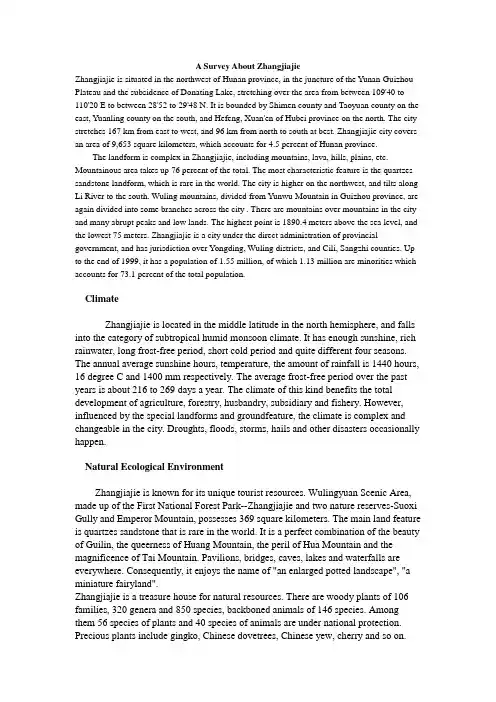
A Survey About ZhangjiajieZhangjiajie is situated in the northwest of Hunan province, in the juncture of the Yunan-Guizhou Plateau and the subsidence of Donating Lake, stretching over the area from between 109'40 to 110'20 E to between 28'52 to 29'48 N. It is bounded by Shimen county and Taoyuan county on the east, Yuanling county on the south, and Hefeng, Xuan'en of Hubei province on the north. The city stretches 167 km from east to west, and 96 km from north to south at best. Zhangjiajie city covers an area of 9,653 square kilometers, which accounts for 4.5 percent of Hunan province.The landform is complex in Zhangjiajie, including mountains, lava, hills, plains, etc. Mountainous area takes up 76 percent of the total. The most characteristic feature is the quartzes sandstone landform, which is rare in the world. The city is higher on the northwest, and tilts along Li River to the south. Wuling mountains, divided from Yunwu Mountain in Guizhou province, are again divided into some branches across the city . There are mountains over mountains in the city and many abrupt peaks and low lands. The highest point is 1890.4 meters above the sea level, and the lowest 75 meters. Zhangjiajie is a city under the direct administration of provincial government, and has jurisdiction over Yongding, Wuling districts, and Cili, Sangzhi counties. Up to the end of 1999, it has a population of 1.55 million, of which 1.13 million are minorities which accounts for 73.1 percent of the total population.ClimateZhangjiajie is located in the middle latitude in the north hemisphere, and falls into the category of subtropical humid monsoon climate. It has enough sunshine, rich rainwater, long frost-free period, short cold period and quite different four seasons. The annual average sunshine hours, temperature, the amount of rainfall is 1440 hours, 16 degree C and 1400 mm respectively. The average frost-free period over the past years is about 216 to 269 days a year. The climate of this kind benefits the total development of agriculture, forestry, husbandry, subsidiary and fishery. However, influenced by the special landforms and groundfeature, the climate is complex and changeable in the city. Droughts, floods, storms, hails and other disasters occasionally happen.Natural Ecological EnvironmentZhangjiajie is known for its unique tourist resources. Wulingyuan Scenic Area, made up of the First National Forest Park--Zhangjiajie and two nature reserves-Suoxi Gully and Emperor Mountain, possesses 369 square kilometers. The main land feature is quartzes sandstone that is rare in the world. It is a perfect combination of the beauty of Guilin, the queerness of Huang Mountain, the peril of Hua Mountain and the magnificence of Tai Mountain. Pavilions, bridges, caves, lakes and waterfalls are everywhere. Consequently, it enjoys the name of "an enlarged potted landscape", "a miniature fairyland".Zhangjiajie is a treasure house for natural resources. There are woody plants of 106 families, 320 genera and 850 species, backboned animals of 146 species. Among them 56 species of plants and 40 species of animals are under national protection. Precious plants include gingko, Chinese dovetrees, Chinese yew, cherry and so on.Valuable medicinal herbs include glossy ganoderma, the tuber of elevated gastrodia, the tuber of multiflower knotweed, the bark of eucommia and so on; while rare animals, the giant salamander, unicorn, Sumen antelope, south China tiger, leopard, macaque, zibet and so on.Zhangjiajie enjoys its rich forest resources. It has 1012 acres for forest, which covers 64.61 percent of the entire city and ranks NO.1 in Hunan province. The project of "Beautifying, Purifying and Illuminating" is being carried out. There are 1.55 square meters green land per person. Undoubtedly, it is an ideal ecological tourist zone and an international holiday village.EconomyBefore reform and opening up, the main economy in Zhangjiajie is traditional agriculture and the only industry is limited to the self-sufficient "five small industries". After the year 1978 when the 11th Commission of the Communist Party of China was held, opening-up policy promotes the development of tourism, which in turn boosts the regional economy and people's living standard. Over a decade since the foundation of the city, the municipal government has attached great importance to the tourism as a pillar industry to promote the development of the economy and have made great achievements. Zhangjiajie is becoming world-famous step by step.CultureZhangjiajie raises excellent people and contains various resources. The long history of many nations, original customs together with modern culture contribute to a colorful painting.Zhangjiajie is a habitation for minority nationalities. During the long history, Han people, Tujia people, Miao people, Bai people together with the people of other nationalities co-create a unique culture.Zhangjiajie, a fairyland gathering essence of the heaven, has brought up thousands of elites in the hundreds of years. Among them, there are He Long-the great Chinese proletarian revolutionary leader, one of the founders of PLA, one of the ten marshals in China; Xiang Dakun, the leader of a great peasant uprising; He Pengfei, an assistant commandant in the navy of PLA; Liu Mingdeng, a chief of Taiwan soldiers in Qing Dynasty; and Chen Nengkuan, the receiver of "Two Missiles & One Satellite Medals". Due to the reform and opening-up for more than two decades, special culture, campus culture, community culture, traveling culture, and other modern cultures constitute the lively and colorful culture world of Zhangjiajie; while inheriting traditional advantages and creating some new features as well. Now the number of cultural entertainment places, including cinemas, singing-dancing halls, cultural clubs, parks reaches more than 1000. The city also enjoys 3 public libraries with 105,000 books, 5 regional TV stations and 5 broadcasting stations, which cover all the urban and rural areas. There are 1599 schools of all levels with 251,100 students in all.Zhangjiajie is named after the Zhangjiajie Scenic Area. In 1979 Zhangjiajiesefound this rare forest in the world. In 1982, after the permission of the State Council, the State Planning Committee approved Zhangjiajie to be the first national forest park in China. In 1988, Dayong city where Zhangjiajie is located, jointly combined with Sangzhi where the Emperor Mountain lies and Cili where Suoxi Gully sits, became a city under the direct administration of provincial government. In 1992, Wulingyuan nature reserve, consisting of Zhangjiajie national forest park, the Emperor Mountain reserve and Suoxi Gully reserve, has been listed in the "World Natural Heritage" by UNESCO. In 1994, Dayong city was renamed as Zhangjiajie city under the permission of the State Council. Now, Zhangjiajie has basically become a large-scale, high-rank tourist resort where mountains, lakes, caves and historical culture and special customs are well blended in the area of 500 square kilometers. It has Zhangjiajie National Forest Park, Emperor Mountain reserve and Suoxi Gully reserve as its core, and Maoyan River, Nine-Heaven cave, Five-Thunder Mountain, and the Universal Light Temple as its satellite tourist resorts. So far, more than 20 scenic spots have been explored, and more than 30 tourist routes have been formed. The total traveling lane adds up to more than 500 km.。
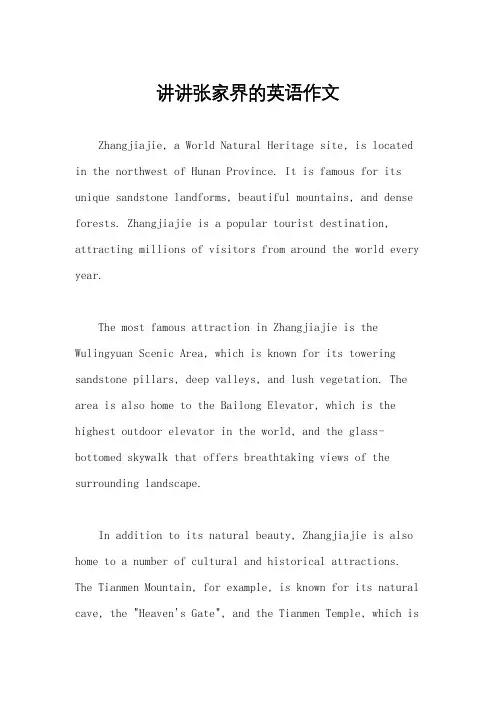
讲讲张家界的英语作文Zhangjiajie, a World Natural Heritage site, is located in the northwest of Hunan Province. It is famous for its unique sandstone landforms, beautiful mountains, and dense forests. Zhangjiajie is a popular tourist destination, attracting millions of visitors from around the world every year.The most famous attraction in Zhangjiajie is the Wulingyuan Scenic Area, which is known for its towering sandstone pillars, deep valleys, and lush vegetation. The area is also home to the Bailong Elevator, which is the highest outdoor elevator in the world, and the glass-bottomed skywalk that offers breathtaking views of the surrounding landscape.In addition to its natural beauty, Zhangjiajie is also home to a number of cultural and historical attractions. The Tianmen Mountain, for example, is known for its natural cave, the "Heaven's Gate", and the Tianmen Temple, which isa Buddhist temple that dates back to the Tang Dynasty. The Yellow Dragon Cave is another popular tourist destination, known for its underground rivers, waterfalls, and limestone formations.One of the best ways to experience the beauty of Zhangjiajie is to take a cable car ride through the mountains. The cable car offers stunning views of the surrounding landscape and allows visitors to see the sandstone pillars up close. Another popular activity in Zhangjiajie is hiking, with numerous trails that lead to scenic viewpoints and hidden waterfalls.In addition to its natural and cultural attractions, Zhangjiajie is also known for its rich biodiversity. The area is home to a wide variety of plant and animal species, including rare and endangered species such as the Chinese giant salamander and the South China tiger. The Zhangjiajie National Forest Park, which is part of the Wulingyuan Scenic Area, is a designated UNESCO World Heritage site and is home to some of the oldest and most diverse forests in China.Overall, Zhangjiajie is a truly unique and breathtaking destination that offers something for everyone. Whether you are interested in hiking, photography, or simply enjoying the beauty of nature, Zhangjiajie has something to offer. With its stunning landscapes, rich cultural heritage, and diverse wildlife, it is no wonder that Zhangjiajie is considered one of the most beautiful places in China. A visit to Zhangjiajie is an experience that will stay with you forever, and it is a destination that should not be missed.。
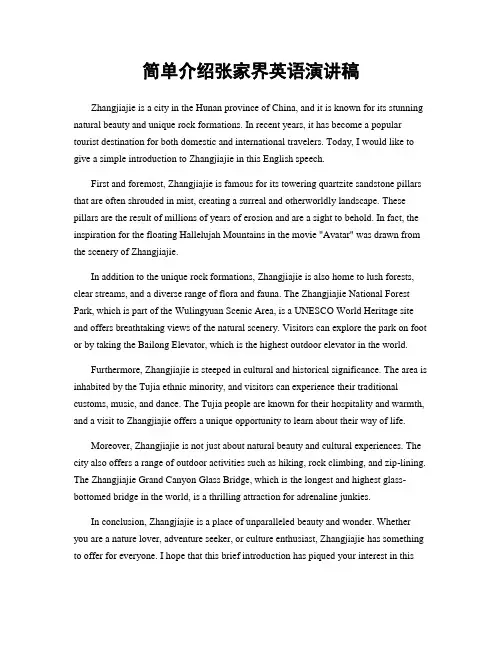
简单介绍张家界英语演讲稿Zhangjiajie is a city in the Hunan province of China, and it is known for its stunning natural beauty and unique rock formations. In recent years, it has become a popular tourist destination for both domestic and international travelers. Today, I would like to give a simple introduction to Zhangjiajie in this English speech.First and foremost, Zhangjiajie is famous for its towering quartzite sandstone pillars that are often shrouded in mist, creating a surreal and otherworldly landscape. These pillars are the result of millions of years of erosion and are a sight to behold. In fact, the inspiration for the floating Hallelujah Mountains in the movie "Avatar" was drawn from the scenery of Zhangjiajie.In addition to the unique rock formations, Zhangjiajie is also home to lush forests, clear streams, and a diverse range of flora and fauna. The Zhangjiajie National Forest Park, which is part of the Wulingyuan Scenic Area, is a UNESCO World Heritage site and offers breathtaking views of the natural scenery. Visitors can explore the park on foot or by taking the Bailong Elevator, which is the highest outdoor elevator in the world.Furthermore, Zhangjiajie is steeped in cultural and historical significance. The area is inhabited by the Tujia ethnic minority, and visitors can experience their traditional customs, music, and dance. The Tujia people are known for their hospitality and warmth, and a visit to Zhangjiajie offers a unique opportunity to learn about their way of life.Moreover, Zhangjiajie is not just about natural beauty and cultural experiences. The city also offers a range of outdoor activities such as hiking, rock climbing, and zip-lining. The Zhangjiajie Grand Canyon Glass Bridge, which is the longest and highest glass-bottomed bridge in the world, is a thrilling attraction for adrenaline junkies.In conclusion, Zhangjiajie is a place of unparalleled beauty and wonder. Whether you are a nature lover, adventure seeker, or culture enthusiast, Zhangjiajie has something to offer for everyone. I hope that this brief introduction has piqued your interest in thisextraordinary destination, and I encourage you to visit Zhangjiajie to experience its magic for yourself. Thank you.。
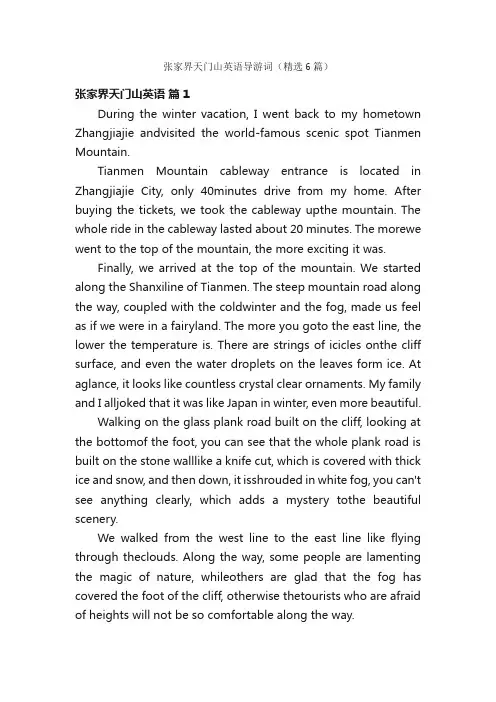
张家界天门山英语导游词(精选6篇)张家界天门山英语篇1During the winter vacation, I went back to my hometown Zhangjiajie andvisited the world-famous scenic spot Tianmen Mountain.Tianmen Mountain cableway entrance is located in Zhangjiajie City, only 40minutes drive from my home. After buying the tickets, we took the cableway upthe mountain. The whole ride in the cableway lasted about 20 minutes. The morewe went to the top of the mountain, the more exciting it was.Finally, we arrived at the top of the mountain. We started along the Shanxiline of Tianmen. The steep mountain road along the way, coupled with the coldwinter and the fog, made us feel as if we were in a fairyland. The more you goto the east line, the lower the temperature is. There are strings of icicles onthe cliff surface, and even the water droplets on the leaves form ice. At aglance, it looks like countless crystal clear ornaments. My family and I alljoked that it was like Japan in winter, even more beautiful.Walking on the glass plank road built on the cliff, looking at the bottomof the foot, you can see that the whole plank road is built on the stone walllike a knife cut, which is covered with thick ice and snow, and then down, it isshrouded in white fog, you can't see anything clearly, which adds a mystery tothe beautiful scenery.We walked from the west line to the east line like flying through theclouds. Along the way, some people are lamenting the magic of nature, whileothers are glad that the fog has covered the foot of the cliff, otherwise thetourists who are afraid of heights will not be so comfortable along the way.We stop and go, about three hours later, we came to the most famous Tianmencave. But this time, because of the ice and snow weather at the top of themountain, the entrance has been closed. We can't go down the stairs to thebottom of Tianmen cave, we can only look down at Tianmen cave from the top ofthe mountain. Although I just looked down and far away, I was already amazed athow such a big natural cave was formed! My aunt who had been to Tianmen cavetold me that the cave is very big, and people would feel very small when theystand under it! The cave is so big that even a plane stunt once flew throughit!If you want to experience the magic and mysterious Tianmen Mountain, pleasecome to my hometown Zhangjiajie, I can be your guide!张家界天门山英语导游词篇2Tianmen Mountain was called Yunmeng Mountain in ancient times, also knownas Yuping mountain. It is located 10 kilometers south of Zhangjiajie City. In263 ad, because of the collapse of the mountain wall, a door was opened in theupper part of the mountain, connecting the north and the south. During the ThreeKingdoms period, sun Xiu, king of Wu, thought it was auspicious and named it"Tianmen Mountain". Tianmen cave is located on the cliff at an altitude of morethan 1260 meters. It is 131.5 meters high, 57 meters wide and more than 60meters deep. According to the research of geological experts, the central partof the entrance is the intersection of the syncline of the East and West rocklayers. Due to the compression, the rock was broken and collapsed, and theentrance was finally formed in 263. Tianmen Mountain is 1517.9 meters above sealevel. Because the relative height difference between Tianmen Mountain anddowntown area is more than 1300 meters, Tianmen Mountainis especially tall andstraight. Its beautiful skyline is a typical example of Tianmen Mountain.Tianmen Mountain is a national 5A tourist area. It is also known as"China's 50 most worthy places for foreigners to visit, China's most desirableplaces, Hunan's new Xiaoxiang eight scenic spots, China's top 100 self drivingscenic spots, and China's top 10 scenic spots most concerned by Internetusers".The unique karst platform landform of Tianmen Mountain is rare all over theworld. It is a isolated mountain with precipices around it. The heightdifference within a few kilometers reaches more than 1300 meters, which createsthe magnificent momentum of the towering isolated peak. The top part of themountain is relatively flat, covering an area of 2 square kilometers, with aforest coverage rate of 90%. There are many strange rocks and trees. It has arare Davidia involucrata community in the world. It is wild all year round, justlike a beautiful sky garden. In July 1992, Tianmen Mountain was approved by theMinistry of forestry as the second National Forest Park in Zhangjiajie. The poetWang Xinjian's poem "walking on Tianmen Mountain" says: "I wandered for a longtime in my dreams several times, and the breeze came ten li to step on theflowers. Step by step, the sky steps lead to the silver Han, and the vast cloudpath encircles the green cliff. The ancient temples are hidden in the secludedvalley, and the screen is rugged and moving to Penglai. And bathe the haze intothe wonderland, already Chengxin near Yaotai. "张家界天门山英语导游词篇3Dear friendsHello everyone! Welcome to Tianmen Mountain, the national AAAAA scenic spotand National Forest Park. Tianmen Mountain,1518.6 meters above sea level, isthe highest mountain in Zhangjiajie. It is named after Tianmen cave, a naturalwonder. It is known as "the soul of Zhangjiajie" and "the first holy mountain inWestern Hunan" for its profound historical culture and colorful cultural relics.Tianmen Mountain is divided into four scenic spots, namely "Tianmen dongkai","Biye Yaotai", "fairyland" and "Tianjie Buddhist kingdom". There are only winterand spring in four seasons. Summer is a good place to cool off and winter is agood place to ride on ice and snow. The mountains are foggy, with an average of230 days a year. The sea of clouds and waterfalls often appear, which isamazing.Tianmen Mountain is not only unique in natural scenery, but also has manyof the world's most artificial wonders. From the world's longest high mountainpassenger ropeway, Tongtian Avenue, the world's first highway wonder, toZhangjiajie's first high-altitude viewing cable car, to Guigu plank road andglass plank road above the cliff, every landscape facility can give you adifferent surprise.With a total length of 7455 meters, Tianmen Mountain ropeway is the longestpassenger ropeway in the world. From the cableway station out, in front of thistwo-story building is Li Na villa. In 1997, Li Na, a famous singer, came toTianmen Mountain. She saw that the mountains and rivers here are strange, thewater is clear, and the human relationship is simple. For many years, she hasbeen deeply attracted by the religious culture of Tianmen Mountain, so she movedto Zhangjiajie to pursue her ideal state of Zen.Lingxiaotai is one of the best scenic spots in Tianmen Mountain. Theterrain here is extremely high and the vision is vast. You can have a panoramicview of the mountains, rivers,countryside and cities. Sometimes there areclouds and fog around your feet, which makes you feel like a fairy. This sceneis just like overlooking the mortal scenery in the mythical Lingxiao hall, so itis named Lingxiao terrace.Lingxiao platform for Yihong pass. There is a red pine peak here, which wasnamed after the rain master of Shennong, chisongzi, who practiced here. There isa bottomless Canyon in the middle of Chisong peak. There is a natural stonebridge on the canyon, which is like a rainbow connecting the two ends. It iscalled "Duanshan Hongqiao", and the name of yihongguan comes from it. It's anatural echo wall. Especially, you have to wait patiently for 5 seconds to hearthe echo here.The ghost Valley plank road under your feet is named because it issuspended above the ghost Valley cave. Because of its high risk and wide fieldof vision, it has become a star scenic spot of Tianmen Mountain, which has beenpraised by people all over the world. With a total length of 1600 meters and anaverage altitude of 1400 meters, the trestle road is an unforgettable cliffexperience.Tianmenshan temple, known as the Buddhist Center in Western Hunan, wasbuilt in the Ming Dynasty. After the fusion of Confucianism, Taoism andBuddhism, the temple has been prosperous ever since. Now the temple is rebuiltin the original site, covering an area of more than 20000 square meters. It isthe highest Buddhist building complex in Hunan at present. The whole templeadopts the official style of ancient China, and is composed of the main hall,Guanyin Pavilion, sutra Pavilion and other buildings. The temple also worshipsthe real body relic of Sakyamuni, his two disciples muqianlian and the relicBuddha. It is also the only temple in Hunan Province to offer the Buddharelic.Next, we are going to challenge the glass plank road, which is known as"the road of Oriental sky". The plank road is 60 meters long and the highestaltitude is 1430 meters. In addition to the trestle road every one meter or sowith reinforced concrete to build a section of support, all are highlytransparent tempered glass, each piece of glass can withstand 1000 kg, sopersonal safety is completely guaranteed.Tianmen cave formed in the Three Kingdoms period, is the essence ofTianmenshan Mountain attractions. To get to Tianmen cave, you have to passthrough the Tongtian Avenue, which is known as "the first highway wonder in theworld". With a total length of 11 kilometers and sharp curves, Tongtian Avenueis also known as "Tianlu" because of its unique and high risk. After 99 bends ofTongtian Avenue, you can enjoy the style of Tianmen cave from a short distance.The towering cliffs on both sides make the Tianmen cave particularlyspectacular. There is no human landscape in the cave, only blue sky, whiteclouds and wisps of mist. It seems that you can reach the heaven directly afteryou step over. Before and after the rain, when the water vapor is abundant, thewind and cloud in Tianmen cave are surging, and the transpiration fog is like awhite dragon circling in and out of the cave, forming a unique and spectacular"Tianmen spitting fog".Tianmen cave is the highest natural karst cave in the world. It runs fromnorth to south. The gate is 131.5 meters high, 57 meters wide and 60 metersdeep. In 1999, the world's aerobatic master once flew through Tianmen cave,achieving another feat of human challenging nature. The performance caused asensation in the world, with 800 million viewers watching the live broadcast,and Tianmen Mountain has become the focus ofthe world since then.Well, that's all for the explanation of Tianmen Mountain. Please give usmore valuable opinions on the shortcomings. Thank you!张家界天门山英语导游词篇4One day, my uncle took us to visit Tianmen Mountain. Tianmen Mountain islocated at the junction of Xinning County in Hunan Province and Ziyuan County inGuangxi Province. It is also a natural scenic spot of Danxia Diyan.In the early morning, my uncle drove all the way, and the cool mountainwind came in front of me. It was chilly. "It's July. It was so cold yesterday.It seems that the temperature difference between the mountain and the city isreally big." I muttered. About 40 minutes by car, finally came to thedestination - Tianmen Mountain.As soon as I get out of the car, I don't know when the "depressed" sky hasopened a smiling face. Come to the foot of the mountain, a piece of denseforest, covering the distant view of the line of sight, a tortuous andmysterious stone path curved to the far peak. Climbing up the path, the greentrees sprout in the mountain. From the gap between the leaves, there are a fewrays of sunshine occasionally. The birds are singing tactful "Songs" on thetrees intermittently. A clear stream murmurs, and clusters of bright redwildflowers sometimes emerge from the bushes. I took a deep breath, the airmixed with a faint fragrance.The mountain road is getting steeper and steeper, and the climbing is notas easy as before. Passing a pavilion halfway up the mountain, I hesitatedwhether to continue. Suddenly, a bright light not far away attracted my eyes.There is a dazzling light between the two cliffs, which seems to light a brightlight on thedark valley. Looking up, people are like frogs at the bottom of awell, only a line of blue sky can be seen. Do I really want to stop and be atoad? No, I should be the "Eagle" at the top of Lingfeng mountain. I gritted myteeth and persisted. I climbed countless steps and finally reached the top ofTianmen Mountain.Standing on the top of the mountain, you can see the mountains, the clouds,the river like a green belt, the wind passing, the mountains rolling, the wildflowers swaying in the jungle, the endless scenery, it's like a naturallandscape paintingI love climbing, and I love the "scenery" after climbing!张家界天门山英语导游词篇5Friends: I believe you are not unfamiliar with Tianmen Mountain. The worldaerobatics Grand Prix held in November 1999 completed the feat of human flyingthrough natural karst caves for the first time, and the name of Tianmen Mountainsuddenly entered the world's vision. How many people hope to have a glimpse ofTianmen Mountain. Today, you finally get what you want!Tianmen Mountain was called Songliang mountain in the Han Dynasty. In theThree Kingdoms period, a door was opened on the wall of the mountain. Sun Xiu,king of Wu, regarded it as an auspicious omen and renamed it Tianmen Mountain.Tianmen Mountain is a masterpiece of nature. In the long geological history, ithas experienced marine sedimentation rising to continental sedimentation,forming a high mountain, and suffered hundreds of millions of years of wind andrain erosion, especially the Triassic Yanshan movement. At the end of theCretaceous, the large-scale Himalayan orogeny further uplifted the TianmenMountain, which was cut into isolated mountains by two fault canyons, resultingin a great heightdifference between the high mountains and the valley, with aheight difference of more than 1300 meters within a few kilometers, thuscreating the majestic momentum of the isolated peaks of the TianmenMountain.Tianmen Mountain is a mysterious carrier of historical culture and Buddhismculture, and a perfect combination of natural landscape and human landscape. Inorder to speed up the process of tourism development in Zhangjiajie, TianmenMountain is in the process of large-scale development and construction. Somescenic spots have not been officially opened; the world's longest ropeway andTianmenshan temple are under construction. So, how did Tianmen cave form?Geologist Mr. Qin gongjiong thought that it was the result of "funnel"dissolution. He thinks that the terrain on the east side of Tianmen caveinclines slightly to the west, while the terrain on the west side inclinesslightly to the East, and the core of syncline is facing Tianmen cave road. TheEast and west walls are cut by two joints with a strike of about 320 degrees,and a joint with a strike of 40 degrees intersects with them at Tianmen cave.Two karst funnels at the top of the cave also play an important role in thekarst process. After the rain falls, the surface water flows along the slope tothe funnel, and part of the water flowing into the soil flows down theinterlayer cracks of the stratum towards the core of the syncline. The long-termcontinuous dissolution process makes the local collapse, and finally makes thetwo groups of caves merge into one, forming the Tianmen cave.However, some people disagree with this: the Tianmen cave was formedaccording to this principle. Why is the base of the cave a huge platform? Canthese rocks "collapse" out of the cave? Therefore, the formation of Tianmen caveis still an unsolvedmystery.(Tianmenshan Temple) Tianmenshan temple was first built in the TangDynasty. It was called Yunbo temple, Lingquan courtyard and Songliang hall inancient times. In the Ming Dynasty, due to improper site selection, it wasrepeatedly destroyed by wind and often suffered from water shortage, soTianmenshan temple was moved from the eastern peak. It used to be a place withtowering ancient trees and thick shade. The lintel of the ancient temple isengraved with the four characters "Tianmen Xianshan". The couplet on both sidesof the gate is: "there is no night in the sky, and there is no mountain on themountain. It is said that Li Zicheng wrote a book by Ye Fu. The entrance is theGreat Buddha Hall, behind which is the Guanyin hall, with six bungalows on bothsides. The last one is the ancestral hall, which is of great scale. Folk can besummarized as "three into the hall, six ear room, brick wall, iron pot, such asKuang". The original architecture of the temple is very particular, withcornices and angles, carved dragons and painted phoenixes, and statues ofBuddhas and Bodhisattvas. There is also a big drum, a big bell, a seven levelstone tower and a Dahua money stove. According to the inscriptions, Tianmenshantemple was repaired seven times during the 163 years from the Qianlong period ofthe Qing Dynasty to the fifth year of the Republic of China. At that time, therewas an endless stream of believers from more than ten counties along the borderof Hunan, Hubei, Sichuan and Guizhou. Now Tianmenshan Tourism Co., Ltd. isrepairing Tianmenshan temple on a large scale, and the former prosperity willreappear. (longtouyan) it's called longtouyan. In the past, there were stonetaps that could be turned on the collapse. Longtou rock faces a cliff. It issaid that in the past, many pilgrims, in order toshow their sincerity inpraying for God and worshiping Buddha, held the dragon's head in their hands andmade a circle around the cliff. As long as they were sincere, they wouldguarantee you nothing. Later, the dragon head was lifted off the cliff. Now wecan only see the stone pit where the dragon head was placed. Longtou rock is thebest viewing platform for sunrise and sea. Li Jing, the magistrate of Yuezhou inthe Ming Dynasty, wrote a poem praising the Tianmen Mountain: the mountain hasreached its peak, and the Tianmen gate is close to the mountain. Looking up atPenglai under the red sun, looking forward to Lufu white clouds. Cangya abruptpine fir ancient, Qujing remote horse trace empty. If you want to build thehighest peak, flying must rely on the sky wind. (chisongfeng gold pool) thissmall pool is about 1.3 meters long, 0.6 meters wide and only a few centimetersdeep. No matter how dry it is, the water will not dry up all the year round. Itis said that this is the gold pool of chisongzi, the rain master of Shennongemperor in ancient times. Under the northern cliff, there is a peak like Danzaopeak, which is called Danzao peak. At the top of the peak, there are clouds andmist, like the smoke rising from the stove. It is said that it is a stove usedby red pine nuts for alchemy. There is a poem by predecessors: "in the past,there were immortal places. The relics are left in Danzao, and they often comeand go. " There are thunder cave and electricity cave under the peak of Danzao.It is said that in addition to using the water from the golden pool, the redpine nut can reach a certain degree of fire with the help of thunder andelectricity. There are a lot of strange things in Tianmen Mountain, but thetruth is not clear. Among them, there are four ancient mysteries, which havebeen handed down from generation to generation. The first is the mystery ofTianmenopening, the second is the mystery of Guiguzi developing, the third isthe mystery of turning the water on the top of the mountain, and the fourth isthe mystery of wild Buddha's treasure. It is said that under the beech tree isthe treasure house of the wild Buddha. In the chapter "Tianmen Mountain" in thelocal records of Yongding County written by Guangxu of the Qing Dynasty, it issaid that "in the Ming Dynasty, the wild Buddha flew to this mountain fromJiashan temple. The wild Buddha was a bandit. After the incident, he cut off hishair and became a monk. He escaped from heaven. " (ghost Valley cave) it is saidthat when Li Zicheng took Yefu up the mountain, he took more than 100 people andhorses and many gold and silver treasures, hired nine wooden boats to sneak intoDayong secretly against the Li River, and went up Tianmen Mountainunconsciously. This time Yefu became a monk, he didn't really want to become aBuddha. Instead, he "sleeps" every day and "draws his sword to the altar" to"restore the Central Plains" and "wipe out the whole world" one day. However,the situation took a sharp turn, the peasant army collapsed, the Qing governmentwas established, and Yefu finally died of anxiety. It is said that before hedied, he scattered all the treasures he had brought and hid them in severalsecret places in Tianmen Mountain. And poisoned all the migrant workers todeath. For hundreds of years, I don't know how many bandits, pilgrims andmysterious monks of Tianmen Mountain have come to Tianmen to worship. In fact,they have come back empty handed to peep at the terrain and search for treasure.Where the treasure is hidden is always a mystery.张家界天门山英语导游词篇6朋友们:相信大家对天门山并不陌生。
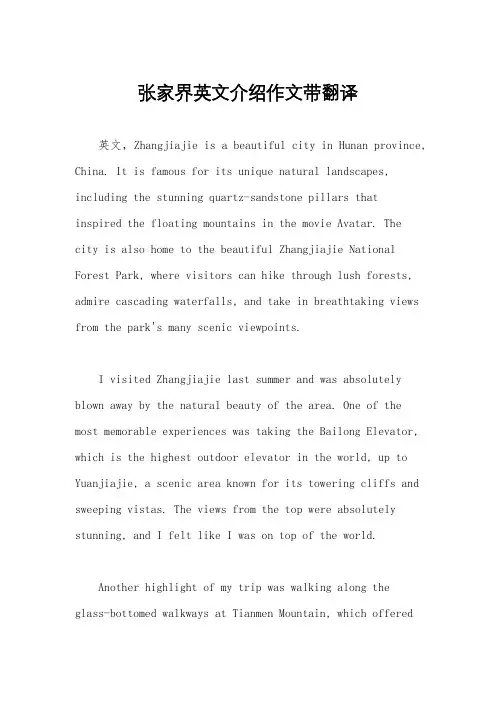
张家界英文介绍作文带翻译英文,Zhangjiajie is a beautiful city in Hunan province, China. It is famous for its unique natural landscapes, including the stunning quartz-sandstone pillars thatinspired the floating mountains in the movie Avatar. Thecity is also home to the beautiful Zhangjiajie National Forest Park, where visitors can hike through lush forests, admire cascading waterfalls, and take in breathtaking views from the park's many scenic viewpoints.I visited Zhangjiajie last summer and was absolutely blown away by the natural beauty of the area. One of the most memorable experiences was taking the Bailong Elevator, which is the highest outdoor elevator in the world, up to Yuanjiajie, a scenic area known for its towering cliffs and sweeping vistas. The views from the top were absolutely stunning, and I felt like I was on top of the world.Another highlight of my trip was walking along theglass-bottomed walkways at Tianmen Mountain, which offeredadrenaline-pumping views of the sheer drop below. It was definitely a bit nerve-wracking at first, but theexperience was exhilarating and something I'll never forget.中文,张家界是中国湖南省的一个美丽城市。
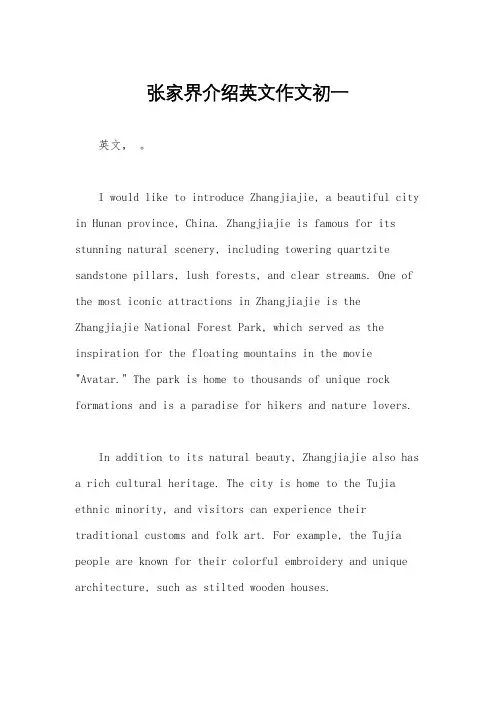
张家界介绍英文作文初一英文,。
I would like to introduce Zhangjiajie, a beautiful city in Hunan province, China. Zhangjiajie is famous for its stunning natural scenery, including towering quartzite sandstone pillars, lush forests, and clear streams. One of the most iconic attractions in Zhangjiajie is the Zhangjiajie National Forest Park, which served as the inspiration for the floating mountains in the movie "Avatar." The park is home to thousands of unique rock formations and is a paradise for hikers and nature lovers.In addition to its natural beauty, Zhangjiajie also has a rich cultural heritage. The city is home to the Tujia ethnic minority, and visitors can experience their traditional customs and folk art. For example, the Tujia people are known for their colorful embroidery and unique architecture, such as stilted wooden houses.Furthermore, Zhangjiajie is a great destination for adventure seekers. The city offers thrilling activitiessuch as glass-bottomed skywalks, zip-lining, and rock climbing. One of the most popular experiences is theBailong Elevator, which is the highest outdoor elevator in the world and offers breathtaking views of the surrounding landscape.Overall, Zhangjiajie is a must-visit destination for anyone who loves nature, culture, and adventure. The city's unique combination of natural beauty and cultural heritage makes it a truly unforgettable experience for travelers.中文:我想介绍一下张家界,这是中国湖南省一个美丽的城市。
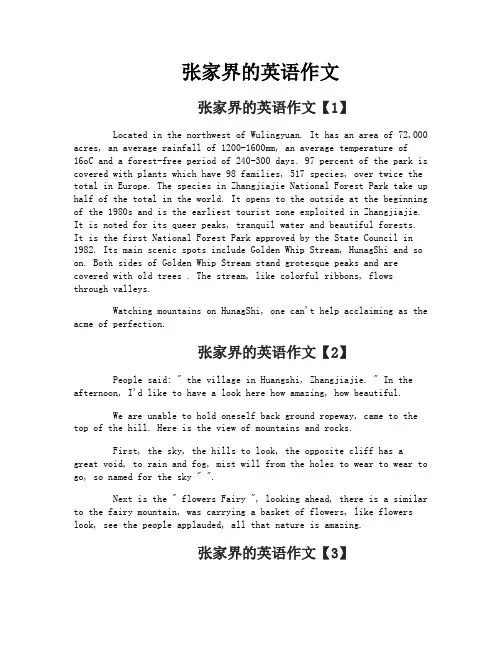
张家界的英语作文张家界的英语作文【1】Located in the northwest of Wulingyuan. It has an area of 72,000 acres, an average rainfall of 1200-1600mm, an average temperature of16oC and a forest-free period of 240-300 days. 97 percent of the park is covered with plants which have 98 families, 517 species, over twice the total in Europe. The species in Zhangjiajie National Forest Park take up half of the total in the world. It opens to the outside at the beginning of the 1980s and is the earliest tourist zone exploited in Zhangjiajie. It is noted for its queer peaks, tranquil water and beautiful forests.It is the first National Forest Park approved by the State Council in 1982. Its main scenic spots include Golden Whip Stream, HunagShi and so on. Both sides of Golden Whip Stream stand grotesque peaks and are covered with old trees . The stream, like colorful ribbons, flows through valleys.Watching mountains on HunagShi, one can't help acclaiming as the acme of perfection.张家界的英语作文【2】People said: " the village in Huangshi, Zhangjiajie. " In the afternoon, I'd like to have a look here how amazing, how beautiful.We are unable to hold oneself back ground ropeway, came to the top of the hill. Here is the view of mountains and rocks.First, the sky, the hills to look, the opposite cliff has a great void, to rain and fog, mist will from the holes to wear to wear to go, so named for the sky " ".Next is the " flowers Fairy ", looking ahead, there is a similar to the fairy mountain, was carrying a basket of flowers, like flowers look, see the people applauded, all that nature is amazing.张家界的英语作文【3】This morning, we went to Zhangjiajie Tourism. Zhangjiajie landscape is really beautiful, bizarre mountains, clear bright and clean water, as well as the cool quiet of the Grand Canyon.But I saw a lot of regret Zhangjiajie, here are my personal feelings.One regret: Native products are fake and unsanitaryEvery meal, the store will recommend rock ear, native Shiershan these are said to be picking from the top down. At the same time, the store will sell these overwhelming tou.You know, Zhangjiajie mostly vertical, not so easy to climb, how there are so many souvenir? This shows that there is certainly false! Also, the vendors selling Layu bacon fly-infested, who dare eat ah?Unfortunately two: attractions restaurants will cheatingEvery restaurant, the waiter will recommend Tujia dishes: a chicken that is not expensive, only 90 yuan; fried potatoes wire 88 yuan;30 cents 50 cents a local snack on fish Jinbian even to 70 yuan . Some stores even made green bean sprouts also sell them to visitors to eat, the result was eating bad stomach.Three Regret: Forest Park, smelly pondWhen we go on the ropeway Huangshizhai found a more than 100 square meters large pond smelly and dirty, too unpleasant. Such astinking pond in China's first national forest park in this beautiful place, incredible! I think this stinking pond should be clean, but why not control a little bit?Look, just because these are likely to Zhangjiajie no future! I really hope that people can wake up in Zhangjiajie, Zhangjiajie governance more beautiful, more lovely!。
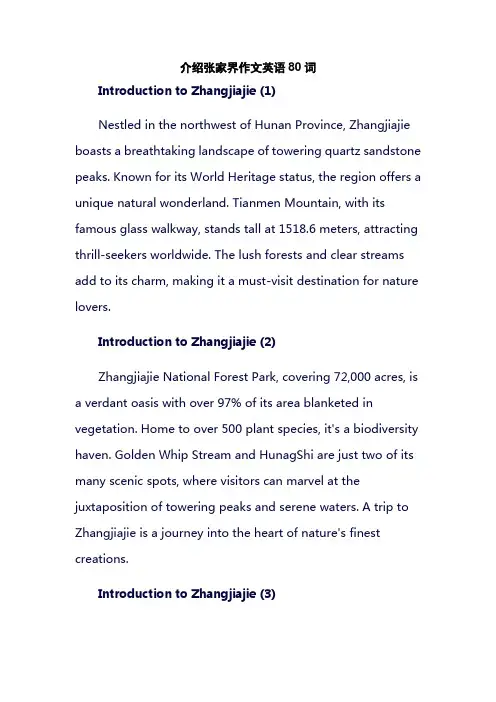
介绍张家界作文英语80词Introduction to Zhangjiajie (1)Nestled in the northwest of Hunan Province, Zhangjiajie boasts a breathtaking landscape of towering quartz sandstone peaks. Known for its World Heritage status, the region offers a unique natural wonderland. Tianmen Mountain, with its famous glass walkway, stands tall at 1518.6 meters, attracting thrill-seekers worldwide. The lush forests and clear streams add to its charm, making it a must-visit destination for nature lovers.Introduction to Zhangjiajie (2)Zhangjiajie National Forest Park, covering 72,000 acres, is a verdant oasis with over 97% of its area blanketed in vegetation. Home to over 500 plant species, it's a biodiversity haven. Golden Whip Stream and HunagShi are just two of its many scenic spots, where visitors can marvel at the juxtaposition of towering peaks and serene waters. A trip to Zhangjiajie is a journey into the heart of nature's finest creations.Introduction to Zhangjiajie (3)Exploring Zhangjiajie is an adventure unlike any other. The city's complex terrain, ranging from mountains to plains, offers a diverse landscape. Longwang Cave, a380-million-year-old limestone marvel, adds to the mystique. Its natural skylight and intricate caverns are testament to the area's geological wonders. Whether hiking along the glass walkway or wandering through the labyrinthine caves, Zhangjiajie promises an unforgettable experience for all.。
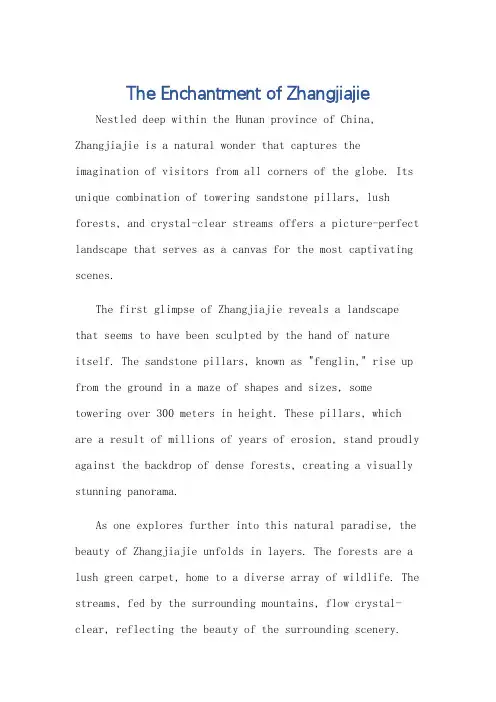
The Enchantment of Zhangjiajie Nestled deep within the Hunan province of China, Zhangjiajie is a natural wonder that captures the imagination of visitors from all corners of the globe. Its unique combination of towering sandstone pillars, lush forests, and crystal-clear streams offers a picture-perfect landscape that serves as a canvas for the most captivating scenes.The first glimpse of Zhangjiajie reveals a landscape that seems to have been sculpted by the hand of nature itself. The sandstone pillars, known as "fenglin," rise up from the ground in a maze of shapes and sizes, some towering over 300 meters in height. These pillars, which are a result of millions of years of erosion, stand proudly against the backdrop of dense forests, creating a visually stunning panorama.As one explores further into this natural paradise, the beauty of Zhangjiajie unfolds in layers. The forests are a lush green carpet, home to a diverse array of wildlife. The streams, fed by the surrounding mountains, flow crystal-clear, reflecting the beauty of the surrounding scenery.Hiking trails lead through this enchanted landscape, allowing visitors to experience its wonders at their own pace.The people of Zhangjiajie are as warm and welcoming as their landscape is beautiful. They are proud of their culture and heritage, and their love for their home is evident in the care they take to preserve its natural beauty. Visitors are often treated to local dishes that are as delicious as they are unique, providing a taste of the region's rich cuisine.Zhangjiajie is not just a place of natural beauty, but also a cultural hotspot. The local villages, with their traditional architecture and vibrant festivals, offer a window into the rich cultural heritage of the area. From the colorful dragon dances to the melodious local music, every aspect of Zhangjiajie's culture is a testament to the resilience and creativity of its people.As the sun sets over Zhangjiajie, the landscape transforms into a different world. The sandstone pillars are bathed in a golden hue, while the forests and streams glow in the fading light. This is a moment of stillness andreflection, where the visitor can appreciate the serenity and grandeur of this remarkable place.Zhangjiajie is a destination that offers something for everyone. Whether you are an adventure seeker looking for hiking trails and outdoor activities, or a cultural aficionado seeking to immerse yourself in local traditions, Zhangjiajie has something to captivate your senses. Its beauty, culture, and warmth make it a place that stays in the hearts of its visitors forever.张家界的魅力位于中国湖南省深处的张家界,是一个令全球游客心驰神往的自然奇观。
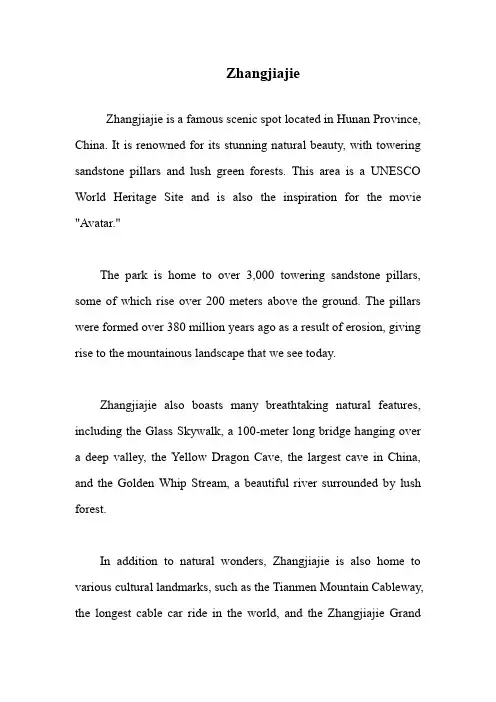
ZhangjiajieZhangjiajie is a famous scenic spot located in Hunan Province, China. It is renowned for its stunning natural beauty, with towering sandstone pillars and lush green forests. This area is a UNESCO World Heritage Site and is also the inspiration for the movie "Avatar."The park is home to over 3,000 towering sandstone pillars, some of which rise over 200 meters above the ground. The pillars were formed over 380 million years ago as a result of erosion, giving rise to the mountainous landscape that we see today.Zhangjiajie also boasts many breathtaking natural features, including the Glass Skywalk, a 100-meter long bridge hanging over a deep valley, the Yellow Dragon Cave, the largest cave in China, and the Golden Whip Stream, a beautiful river surrounded by lush forest.In addition to natural wonders, Zhangjiajie is also home to various cultural landmarks, such as the Tianmen Mountain Cableway, the longest cable car ride in the world, and the Zhangjiajie GrandCanyon Glass Bridge, the longest and highest glass bridge in the world.Overall, Zhangjiajie is a must-see destination for anyone visiting China, offering a pristine natural experience that is unlike any other. That's all for my introduction of Zhangjiajie. If you have any questions about Zhangjiajie, feel free to ask me. Thank you!。
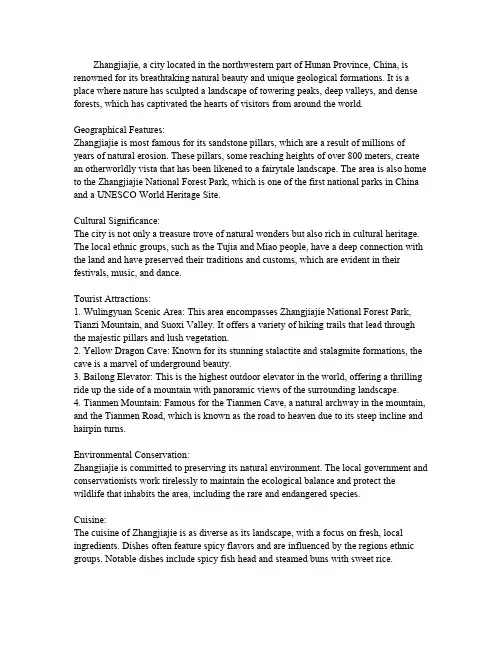
Zhangjiajie,a city located in the northwestern part of Hunan Province,China,is renowned for its breathtaking natural beauty and unique geological formations.It is a place where nature has sculpted a landscape of towering peaks,deep valleys,and dense forests,which has captivated the hearts of visitors from around the world.Geographical Features:Zhangjiajie is most famous for its sandstone pillars,which are a result of millions of years of natural erosion.These pillars,some reaching heights of over800meters,create an otherworldly vista that has been likened to a fairytale landscape.The area is also home to the Zhangjiajie National Forest Park,which is one of the first national parks in China and a UNESCO World Heritage Site.Cultural Significance:The city is not only a treasure trove of natural wonders but also rich in cultural heritage. The local ethnic groups,such as the Tujia and Miao people,have a deep connection with the land and have preserved their traditions and customs,which are evident in their festivals,music,and dance.Tourist Attractions:1.Wulingyuan Scenic Area:This area encompasses Zhangjiajie National Forest Park, Tianzi Mountain,and Suoxi Valley.It offers a variety of hiking trails that lead through the majestic pillars and lush vegetation.2.Yellow Dragon Cave:Known for its stunning stalactite and stalagmite formations,the cave is a marvel of underground beauty.3.Bailong Elevator:This is the highest outdoor elevator in the world,offering a thrilling ride up the side of a mountain with panoramic views of the surrounding landscape.4.Tianmen Mountain:Famous for the Tianmen Cave,a natural archway in the mountain, and the Tianmen Road,which is known as the road to heaven due to its steep incline and hairpin turns.Environmental Conservation:Zhangjiajie is committed to preserving its natural environment.The local government and conservationists work tirelessly to maintain the ecological balance and protect the wildlife that inhabits the area,including the rare and endangered species.Cuisine:The cuisine of Zhangjiajie is as diverse as its landscape,with a focus on fresh,local ingredients.Dishes often feature spicy flavors and are influenced by the regions ethnic groups.Notable dishes include spicy fish head and steamed buns with sweet rice.Transportation:Accessing Zhangjiajie is made easy with the Zhangjiajie Hehua Airport and the citys railway station,which connect it to major cities across China.Within the city,public buses and taxis are readily available for tourists to explore the various attractions. Conclusion:Zhangjiajie is a destination that offers a harmonious blend of natural beauty,cultural richness,and modern convenience.Whether you are an adventure seeker looking to hike the trails or a nature lover seeking tranquility,Zhangjiajie has something for everyone.Its unique landscape continues to inspire awe and wonder,making it a mustvisit destination for travelers worldwide.。
张家界:自然的奇观与文化的瑰宝Zhangjiajie, a city located in the northwest of Hunan province, China, is renowned for its unique natural landscapes and rich cultural heritage. Dubbed as "the original model of Avatar's Hallelujah Mountain,"Zhangjiajie National Forest Park showcases a range of breathtaking sceneries, including towering sandstone peaks, deep gorges, and lush forests.The park's highlight is undoubtedly the "Thousand-Needle Forest," a densely packed area of thin sandstone columns that rise vertically from the ground, resembling an army of sharp needles. These columns, some as tall as 40 meters, are the result of millions of years of geological processes, creating a surreal and otherworldly landscape. Another remarkable feature of Zhangjiajie is its diverse wildlife. The park is home to a variety of endangered species, such as the golden monkey, which adds to the ecological significance of this region. Visitors can enjoy the beauty of these creatures while hiking through the park's trails.Besides its natural wonders, Zhangjiajie also boasts a rich cultural heritage. The local Miao and Tujia ethnic groups have maintained their traditional customs and lifestyles, offering visitors a unique cultural experience. Visitors can learn about the ethnic groups' history, culture, and traditions through various cultural performances and exhibitions.The city of Zhangjiajie also offers a variety of other attractions, including the Tianmen Mountain National Forest Park, Huangshi Village, and the Baofeng Lake. These places further enrich the tourist experience, allowing visitors to explore different aspects of the region's natural and cultural beauty.In conclusion, Zhangjiajie is a must-visit destination for nature lovers and culture seekers alike. Its unique landscapes, rich wildlife, and vibrant ethnic culture offer an unforgettable experience that will leave a lasting impression on any visitor.**张家界:自然的奇观与文化的瑰宝**张家界,位于中国湖南省西北部的一个城市,因其独特的自然景观和丰富的文化遗产而闻名。
张家界景点英文作文带翻译英文,Zhangjiajie is a famous tourist attraction in China, known for its stunning natural scenery and unique rock formations. One of the most famous spots inZhangjiajie is the Zhangjiajie National Forest Park, which inspired the floating mountains in the movie Avatar. The park is filled with towering sandstone pillars, lush forests, and clear streams, creating a truly magical and otherworldly atmosphere.I remember the first time I visited Zhangjiajie, I was completely awestruck by the beauty of the place. The sheer size and scale of the rock formations were unlike anything I had ever seen before. As I hiked through the park, I felt like I was stepping into a different world, surrounded by the towering pillars and the dense foliage. The views from the various viewpoints in the park were absolutely breathtaking, and I couldn't help but take countless photos to capture the stunning scenery.In addition to the National Forest Park, Zhangjiajie also boasts the Tianmen Mountain, which is home to the famous Tianmen Cave, also known as Heaven's Gate. The cave is a natural water-eroded cave in the mountain, and the views from the top are simply incredible. I remember taking the cable car ride up to the mountain, and as I ascended, I could feel the excitement building as I got closer to the cave. When I finally reached the top and stepped out onto the glass walkway that leads to the cave, I was both exhilarated and slightly terrified by the sheer drop below me. It was an experience I will never forget.Overall, Zhangjiajie is a place of unparalleled natural beauty and a must-visit for anyone traveling in China. The unique landscape and the sense of wonder it inspires makeit a truly unforgettable destination.中文,张家界是中国著名的旅游景点,以其令人惊叹的自然风光和独特的岩石形态而闻名。
张家界英语介绍English:Zhangjiajie, located in the Hunan Province of China, is renowned for its breathtaking natural scenery, characterized by towering sandstone pillars, lush forests, and deep ravines. The most iconic feature of Zhangjiajie is the Wulingyuan Scenic Area, a UNESCO World Heritage Site encompassing thousands of these unique rock formations, including the famous Avatar Hallelujah Mountain. Visitors can explore the area via scenic walking trails, glass skywalks, and thrilling cable car rides offering panoramic views of the stunning landscape. Apart from its natural wonders, Zhangjiajie also boasts cultural attractions such as the Tianmen Mountain, home to the Tianmen Cave and the exhilarating Tianmen Mountain Cableway, one of the world's longest cable car rides. Additionally, visitors can immerse themselves in the rich cultural heritage of the Tujia ethnic minority, experiencing traditional performances, crafts, and cuisine. Zhangjiajie's beauty has inspired artists and filmmakers alike, with its surreal landscapes serving as the backdrop for numerous films and paintings. Overall, Zhangjiajie offers a harmonious blend of naturalsplendor, cultural richness, and thrilling adventures, making it amust-visit destination for travelers seeking unforgettable experiences.中文翻译:张家界位于中国湖南省,以其令人惊叹的自然风景而闻名,其特点是高耸的砂岩柱、茂密的森林和深谷。
张家界介绍英语作文Zhangjiajie Introduction。
Zhangjiajie is a city located in the Hunan province of China. It is known for its stunning natural beauty, including towering sandstone pillars, lush forests, and crystal-clear streams. The city is also home to the famous Zhangjiajie National Forest Park, which inspired the floating mountains in the movie Avatar.One of the most iconic features of Zhangjiajie is the Bailong Elevator, also known as the Hundred Dragons Elevator. This glass elevator is built into the side of a cliff and is the highest outdoor elevator in the world. It offers breathtaking views of the surrounding landscape as it ascends to the top of the mountain.Another must-see attraction in Zhangjiajie is the Tianmen Mountain. Visitors can take a cable car ride to the top of the mountain, where they can walk along the Cliff-Hanging Walkway, a narrow pathway that hugs the side of the mountain. The Tianmen Cave, a natural archway that is also known as the "Heaven's Gate," is another popular spot for visitors to take in the stunning views.For nature lovers, Zhangjiajie National Forest Park isa paradise. The park is home to thousands of plant and animal species, including rare and endangered ones.Visitors can explore the park on foot or by taking a bustour through the winding roads that lead to various scenic spots.In addition to its natural beauty, Zhangjiajie also has a rich cultural heritage. The city is home to severalethnic minority groups, including the Tujia and Miao people, who have their own unique customs and traditions. Visitors can learn about the local culture by visiting traditional villages and attending cultural performances.Overall, Zhangjiajie is a destination that offers a perfect blend of natural beauty and cultural heritage. Whether you are a nature lover, an adventure seeker, or aculture enthusiast, there is something for everyone to enjoy in this enchanting city. So, if you ever have the chance to visit Zhangjiajie, be sure to take in all that this amazing city has to offer.。
张家界英语作文小学English:Zhangjiajie is a beautiful city located in the Hunan province of China. It is famous for its stunning natural landscapes, including towering sandstone pillars, deep valleys, and lush forests. One of the most famous attractions in Zhangjiajie is the Zhangjiajie National Forest Park, where visitors can take a cable car up to the Tianzi Mountain and be amazed by the breathtaking views of the unique rock formations. Another must-see spot is the glass-bottomed bridge that spans the Grand Canyon, offering a thrilling experience for those who are brave enough to walk across it. The city is also home to the Bailong Elevator, which is a massive outdoor elevator built into the side of a cliff, providing an incredible way to access the scenic area. In addition to its natural beauty, Zhangjiajie is also rich in culture and history, with the ancient Tianmen Mountain and the charming Tujia ethnic minority villages showcasing the region's diverse heritage. Overall, Zhangjiajie is a remarkable destination for nature lovers and adventure seekers, offering an unforgettable experience in the heart of China.中文翻译:张家界位于中国湖南省,是一个美丽的城市。
A Survey About ZhangjiajieZhangjiajie is situated in the northwest of Hunan province, in the juncture of the Yunan-Guizhou Plateau and the subsidence of Donating Lake, stretching over the area from between 109'40 to 110'20 E to between 28'52 to 29'48 N. It is bounded by Shimen county and Taoyuan county on the east, Yuanling county on the south, and Hefeng, Xuan'en of Hubei province on the north. The city stretches 167 km from east to west, and 96 km from north to south at best. Zhangjiajie city covers an area of 9,653 square kilometers, which accounts for 4.5 percent of Hunan province.The landform is complex in Zhangjiajie, including mountains, lava, hills, plains, etc. Mountainous area takes up 76 percent of the total. The most characteristic feature is the quartzes sandstone landform, which is rare in the world. The city is higher on the northwest, and tilts along Li River to the south. Wuling mountains, divided from Yunwu Mountain in Guizhou province, are again divided into some branches across the city . There are mountains over mountains in the city and many abrupt peaks and low lands. The highest point is 1890.4 meters above the sea level, and the lowest 75 meters. Zhangjiajie is a city under the direct administration of provincial government, and has jurisdiction over Yongding, Wuling districts, and Cili, Sangzhi counties. Up to the end of 1999, it has a population of 1.55 million, of which 1.13 million are minorities which accounts for 73.1 percent of the total population.ClimateZhangjiajie is located in the middle latitude in the north hemisphere, and falls into the category of subtropical humid monsoon climate. It has enough sunshine, rich rainwater, long frost-free period, short cold period and quite different four seasons. The annual average sunshine hours, temperature, the amount of rainfall is 1440 hours, 16 degree C and 1400 mm respectively. The average frost-free period over the past years is about 216 to 269 days a year. The climate of this kind benefits the total development of agriculture, forestry, husbandry, subsidiary and fishery. However, influenced by the special landforms and groundfeature, the climate is complex and changeable in the city. Droughts, floods, storms, hails and other disasters occasionally happen.Natural Ecological EnvironmentZhangjiajie is known for its unique tourist resources. Wulingyuan Scenic Area, made up of the First National Forest Park--Zhangjiajie and two nature reserves-Suoxi Gully and Emperor Mountain, possesses 369 square kilometers. The main land feature is quartzes sandstone that is rare in the world. It is a perfect combination of the beauty of Guilin, the queerness of Huang Mountain, the peril of Hua Mountain and the magnificence of Tai Mountain. Pavilions, bridges, caves, lakes and waterfalls are everywhere. Consequently, it enjoys the name of "an enlarged potted landscape", "a miniature fairyland".Zhangjiajie is a treasure house for natural resources. There are woody plants of 106 families, 320 genera and 850 species, backboned animals of 146 species. Among them 56 species of plants and 40 species of animals are under national protection. Precious plants include gingko, Chinese dovetrees, Chinese yew, cherry and so on.Valuable medicinal herbs include glossy ganoderma, the tuber of elevated gastrodia, the tuber of multiflower knotweed, the bark of eucommia and so on; while rare animals, the giant salamander, unicorn, Sumen antelope, south China tiger, leopard, macaque, zibet and so on.Zhangjiajie enjoys its rich forest resources. It has 1012 acres for forest, which covers 64.61 percent of the entire city and ranks NO.1 in Hunan province. The project of "Beautifying, Purifying and Illuminating" is being carried out. There are 1.55 square meters green land per person. Undoubtedly, it is an ideal ecological tourist zone and an international holiday village.EconomyBefore reform and opening up, the main economy in Zhangjiajie is traditional agriculture and the only industry is limited to the self-sufficient "five small industries". After the year 1978 when the 11th Commission of the Communist Party of China was held, opening-up policy promotes the development of tourism, which in turn boosts the regional economy and people's living standard. Over a decade since the foundation of the city, the municipal government has attached great importance to the tourism as a pillar industry to promote the development of the economy and have made great achievements. Zhangjiajie is becoming world-famous step by step.CultureZhangjiajie raises excellent people and contains various resources. The long history of many nations, original customs together with modern culture contribute to a colorful painting.Zhangjiajie is a habitation for minority nationalities. During the long history, Han people, Tujia people, Miao people, Bai people together with the people of other nationalities co-create a unique culture.Zhangjiajie, a fairyland gathering essence of the heaven, has brought up thousands of elites in the hundreds of years. Among them, there are He Long-the great Chinese proletarian revolutionary leader, one of the founders of PLA, one of the ten marshals in China; Xiang Dakun, the leader of a great peasant uprising; He Pengfei, an assistant commandant in the navy of PLA; Liu Mingdeng, a chief of Taiwan soldiers in Qing Dynasty; and Chen Nengkuan, the receiver of "Two Missiles & One Satellite Medals". Due to the reform and opening-up for more than two decades, special culture, campus culture, community culture, traveling culture, and other modern cultures constitute the lively and colorful culture world of Zhangjiajie; while inheriting traditional advantages and creating some new features as well. Now the number of cultural entertainment places, including cinemas, singing-dancing halls, cultural clubs, parks reaches more than 1000. The city also enjoys 3 public libraries with 105,000 books, 5 regional TV stations and 5 broadcasting stations, which cover all the urban and rural areas. There are 1599 schools of all levels with 251,100 students in all.Zhangjiajie is named after the Zhangjiajie Scenic Area. In 1979 Zhangjiajiesefound this rare forest in the world. In 1982, after the permission of the State Council, the State Planning Committee approved Zhangjiajie to be the first national forest park in China. In 1988, Dayong city where Zhangjiajie is located, jointly combined with Sangzhi where the Emperor Mountain lies and Cili where Suoxi Gully sits, became a city under the direct administration of provincial government. In 1992, Wulingyuan nature reserve, consisting of Zhangjiajie national forest park, the Emperor Mountain reserve and Suoxi Gully reserve, has been listed in the "World Natural Heritage" by UNESCO. In 1994, Dayong city was renamed as Zhangjiajie city under the permission of the State Council. Now, Zhangjiajie has basically become a large-scale, high-rank tourist resort where mountains, lakes, caves and historical culture and special customs are well blended in the area of 500 square kilometers. It has Zhangjiajie National Forest Park, Emperor Mountain reserve and Suoxi Gully reserve as its core, and Maoyan River, Nine-Heaven cave, Five-Thunder Mountain, and the Universal Light Temple as its satellite tourist resorts. So far, more than 20 scenic spots have been explored, and more than 30 tourist routes have been formed. The total traveling lane adds up to more than 500 km.。